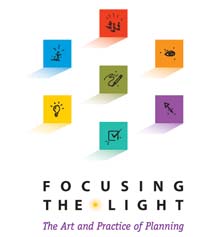Home | Resources | Arts Learning Resources | The Art and Practice of Planning

|
Focusing the Light:
The Art and Practice of Planning
Focusing the Light is now available! This seven-volume series provides those who work in the arts and nonprofits with strategies, tips, and techniques for successful project planning, advocacy and evaluation. Focusing the Light was developed by the Ohio Arts Council to illustrate what is needed to create significant works for communities, secure funding for these initiatives, and evaluate the results. Each of the seven volumes in Focusing the Light offers clear, proven steps to help maximize your efforts and steer your organization toward winning results. With this series, you’ll learn to: Follow the steps in the process sequentially, or focus your efforts on improving and applying one step of the process. This publication is available for FREE to any interested individual or organization. To receive a complimentary seven-volume set by mail please email OAC Arts Learning Program Coordinator Chiquita Mullins Lee, or call 614/728-4455. Please allow 2-3 weeks for delivery.
Volume 1: Arts Advocacy and Strategic Planning-This first volume provides an overview of the public value of the arts and of arts education, the importance of communicating public value through advocacy, and the essential role of strategic planning. Additionally, the volume gives your organization strategic direction with tips on how to focus your vision and mission. Volume 2: Strategic Partnerships-The second volume helps you identify stakeholders for your program plan and presents strategies for building successful partnerships and project teams, techniques to develop and enhance team building skills, and qualities that increase leadership effectiveness and project management. Volume 3: Understanding the Context-The third volume offers techniques for strategic analysis that will help your organization accurately assess the needs, resources, and conditions that will impact your program plan. Volume 4: Building a Program Plan-The fourth volume presents the steps leading to a workable, effective arts program plan, including defining outcomes, identifying strategic activities, outlining the program structure, establishing a feasible project budget, and bringing all of these elements together in an action plan. Volume 5: Creating, Adapting, and Communicating a Strategic Plan-The fifth volume focuses on the process of taking ideas and turning them into a finalized plan, communicating the plan to varied stakeholders or audiences, and adapting components of the plan for specific funding opportunities. Volume 6: Monitoring and Implementing a Strategic Plan-The sixth volume provides knowledge, strategies, and tools for monitoring plan implementation and documenting project activities and results. Volume 7: Strategic Evaluation-The seventh volume examines evaluation as a tool for measuring outcomes, improving programs, and promoting organizational learning. It identifies the components of program evaluations, gives tips on how to write and conduct an effective evaluation, and explains how to interpret and use data from evaluations. Online Bibliography
Focusing the Light iTool
Features of the iTool: The iTool offers two modes of use, depending on your computer competency and understanding of logic models. Wizard Mode Utilizing a series of open-ended prompts, new users are taken step by step through the logic model development process. Expert Mode Experienced users easily navigate the steps within the logic model and can enter, and edit content in any order as well as add, remove, or reprioritize the order of the content. |
 |
|||||